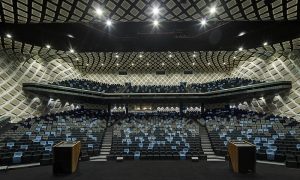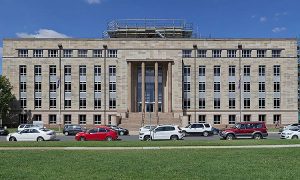In the lead-up to the AIRAH Awards gala dinner on November 15, HVAC&R News is profiling finalists in some of the different categories.
The AIRAH Awards recognise excellence and achievement within HVAC&R, with initial nominations coming from those working within the industry. Click here to see all the finalists for the 2018 awards.
The Excellence in Innovation award, sponsored by Standards Australia, recognises significant Australian improvements in the areas of HVAC&R achieved through innovation. This includes new or significantly improved systems or plant and equipment or processes. It does not include products.
Previous winners include AECOM for AirTrunk Huntingwood (pictured above), Lommers Engineering’s DownUnder GeoSolutions High-Performance Computer Cooling Systems, and Lendlease/A.G. Coombs’ prefabrication approach at Barangaroo.
The finalists for 2018 are:
- A.G. Coombs and AECOM – ICC Sydney Mechanical and HVAC Services
- Airmaster – Tuggeranong Office Park – Building services network project
- Black Stump Technologies – Solar powered deployable mortuary
- Airmaster – John Gorton Building
- Kingspan Insulation Australia – Kingspan Insulation manufacturing facility.
 A.G. Coombs and AECOM –
A.G. Coombs and AECOM –
International Convention Centre
Also a finalist for the Excellence in Sustainability award, this project delivered mechanical and HVAC systems in Sydney’s International Convention Centre (ICC) that set a new benchmark for the Australian industry in terms of innovation, scale, quality and performance.
The precinct HVAC systems are configurable, catering for a range of events varying in size and nature. The systems will support the hosting of concurrent events with a peak population of 32,000 people. The smoke hazard management strategies are unique and accommodate the challenging functionality of the spaces while simultaneously ensuring the safety of its occupants. The facility’s mechanical and HVAC systems in operation have outperformed the energy efficiency design performance targets in their first year.
“Collectively, the sophistication and scale of the systems at ICC Sydney represent a significant step forward for mechanical and HVAC services in Australia,” says Bryon Price, F.AIRAH, strategic development director at A.G. Coombs Group.
 Airmaster –
Airmaster –
Tuggeranong Office Park
Tuggeranong Office Park in Canberra, completed in mid-2017, is a 30,400m2 building comprising five floors of office space and two levels of support facilities, storage and parking. It features floor plates of more than 5,000m2 and a central atrium allowing natural light to flow through the building. It can accommodate up to 2,500 staff.
Airmaster developed a bespoke Building Services Network (BSN) for it. This product streamlines operations and minimises overhead duplications. The BSN uses the common network platform (Ethernet TCP/IP) shared by most technologies used in the operation of a building.
“Airmaster’s engineered design of the BSN infrastructure is a combination of passive structured cabling and active networking, supporting the large amount of information transmitted,” says Airmaster’s Brad Sang. “The result is a stable, failsafe and resilient infrastructure for the day-to-day running of the building that provides a cost-effective solution for the roll-out of site-wide services, now and into the future.”
 Black Stump Technologies –
Black Stump Technologies –
Solar-Powered Deployable Mortuary
In remote places, the consistent supply of electricity from the grid is an almost daily challenge for residents and businesses alike. Following disasters, the only sources of power are usually diesel gensets. Fuel supply then becomes an issue, as does noise and pollution.
This led to Heuch’s development of its range of solar-powered deployable chillers and freezers for humanitarian applications. Heuch created Black Stump Technologies to further develop this technology.
For the ANGAU Memorial Hospital at Lae in Papua New Guinea, the lack of consistent power can play havoc with the day-to-day running of the hospital. A solution was needed while the hospital mortuary was rebuilt.
Working with the Lae Hospital redevelopment team, comprising hospital personnel and Johnstaff Project Management, Black Stump has produced a solar-powered deployable mortuary with customised tray system, giving great comfort and dignity not only to hospital staff but to relatives of the deceased.
 Airmaster –
Airmaster –
John Gorton Building
A heritage-listed, historically significant public service building, the John Gorton Building in Canberra is large and complex. Completed in 1956, it comprises a ground floor, six upper floors (including a plant room on level six), a basement, a sub-basement, and a communications centre.
Airmaster developed and delivered a night audit procedure for the purposes of identifying after-hours plant operation abnormalities, OH&S issues, BMS issues, and energy-saving opportunities/initiatives. Airmaster is also investigating the possibility of implementing a “Total Overview” building management and analytics system.
“This project illustrates innovation through a unique approach to managing and identifying potential improvements for the client by way of a value-added service,” says Airmaster’s Brad Sang. “The night audit resulted in a number of energy efficient and building optimisation solutions, including a lighting upgrade that would result in energy savings of $550,000 over 10 years with a payback period of 1.6 years.”
 Kingspan Insulation –
Kingspan Insulation –
Kingspan Insulation Manufacturing Facility
Also nominated for the Excellence in Sustainability award, Kingspan’s Somerton building was constructed using low environmental impact and low-carbon-impact raw materials that can be reused or recycled, rather than sent to landfill, at the end of their life-cycles.
The gas-fired curing ovens used to manufacture Kingspan’s phenolic boards are one of the site’s most significant users of energy. The innovative design of these ovens has achieved improved quality of finished insulation boards, reduced cycle times (providing higher capacity per oven), and reduced energy requirements.
Being the first manufacturing facility in Australia to apply the Green Star framework also represented major innovation – and challenge. And yet Kingspan’s Neil Cox says that overall it helped the project.
“In many cases, the Green Star framework resulted in us making better overall choices,” he says. “For example, the HVAC systems installed in our main office area utilise 100 per cent external air, with energy recovered from the exhaust used to prepare the intake air.”

